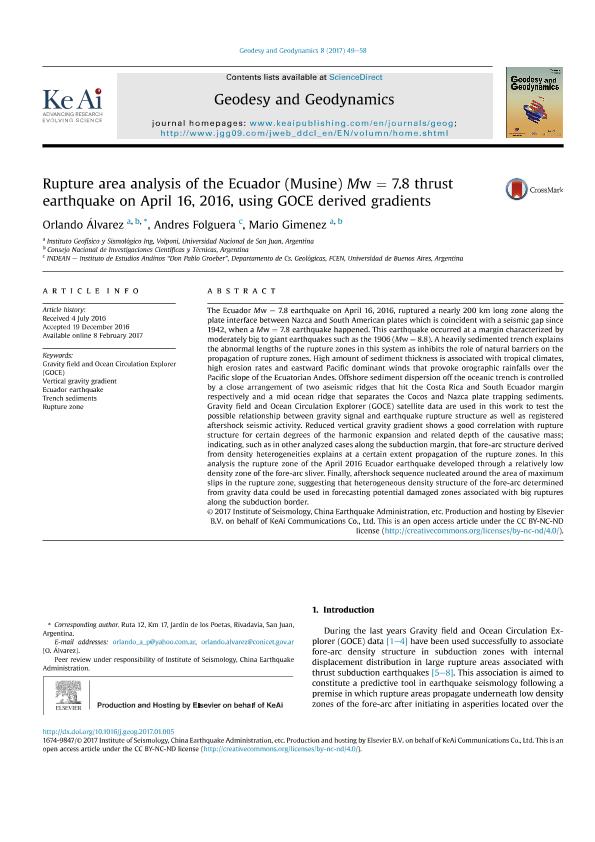Mostrar el registro sencillo del ítem
dc.contributor.author
Alvarez Pontoriero, Orlando

dc.contributor.author
Folguera Telichevsky, Andres

dc.contributor.author
Gimenez, Mario Ernesto

dc.date.available
2019-09-30T20:15:33Z
dc.date.issued
2017-01
dc.identifier.citation
Alvarez Pontoriero, Orlando; Folguera Telichevsky, Andres; Gimenez, Mario Ernesto; Rupture area analysis of the Ecuador (Musine) Mw = 7.8 thrust earthquake on April 16, 2016, using GOCE derived gradients; KeAi Communications; Geodesy and Geodynamics; 8; 1; 1-2017; 49-58
dc.identifier.issn
1674-9847
dc.identifier.uri
http://hdl.handle.net/11336/84853
dc.description.abstract
The Ecuador Mw = 7.8 earthquake on April 16, 2016, ruptured a nearly 200 km long zone along the plate interface between Nazca and South American plates which is coincident with a seismic gap since 1942, when a Mw = 7.8 earthquake happened. This earthquake occurred at a margin characterized by moderately big to giant earthquakes such as the 1906 (Mw = 8.8). A heavily sedimented trench explains the abnormal lengths of the rupture zones in this system as inhibits the role of natural barriers on the propagation of rupture zones. High amount of sediment thickness is associated with tropical climates, high erosion rates and eastward Pacific dominant winds that provoke orographic rainfalls over the Pacific slope of the Ecuatorian Andes. Offshore sediment dispersion off the oceanic trench is controlled by a close arrangement of two aseismic ridges that hit the Costa Rica and South Ecuador margin respectively and a mid ocean ridge that separates the Cocos and Nazca plate trapping sediments. Gravity field and Ocean Circulation Explorer (GOCE) satellite data are used in this work to test the possible relationship between gravity signal and earthquake rupture structure as well as registered aftershock seismic activity. Reduced vertical gravity gradient shows a good correlation with rupture structure for certain degrees of the harmonic expansion and related depth of the causative mass; indicating, such as in other analyzed cases along the subduction margin, that fore-arc structure derived from density heterogeneities explains at a certain extent propagation of the rupture zones. In this analysis the rupture zone of the April 2016 Ecuador earthquake developed through a relatively low density zone of the fore-arc sliver. Finally, aftershock sequence nucleated around the area of maximum slips in the rupture zone, suggesting that heterogeneous density structure of the fore-arc determined from gravity data could be used in forecasting potential damaged zones associated with big ruptures along the subduction border.
dc.format
application/pdf
dc.language.iso
eng
dc.publisher
KeAi Communications
dc.rights
info:eu-repo/semantics/openAccess
dc.rights.uri
https://creativecommons.org/licenses/by-nc-nd/2.5/ar/
dc.subject
ECUADOR EARTHQUAKE
dc.subject
GRAVITY FIELD AND OCEAN CIRCULATION EXPLORER (GOCE)
dc.subject
RUPTURE ZONE
dc.subject
TRENCH SEDIMENTS
dc.subject
VERTICAL GRAVITY GRADIENT
dc.subject.classification
Geoquímica y Geofísica

dc.subject.classification
Ciencias de la Tierra y relacionadas con el Medio Ambiente

dc.subject.classification
CIENCIAS NATURALES Y EXACTAS

dc.title
Rupture area analysis of the Ecuador (Musine) Mw = 7.8 thrust earthquake on April 16, 2016, using GOCE derived gradients
dc.type
info:eu-repo/semantics/article
dc.type
info:ar-repo/semantics/artículo
dc.type
info:eu-repo/semantics/publishedVersion
dc.date.updated
2019-06-06T15:55:58Z
dc.journal.volume
8
dc.journal.number
1
dc.journal.pagination
49-58
dc.journal.pais
China

dc.description.fil
Fil: Alvarez Pontoriero, Orlando. Consejo Nacional de Investigaciones Científicas y Técnicas. Centro Científico Tecnológico Conicet - San Juan; Argentina. Universidad Nacional de San Juan. Facultad de Ciencias Exactas, Físicas y Naturales. Instituto Geofísico Sismológico Volponi; Argentina
dc.description.fil
Fil: Folguera Telichevsky, Andres. Consejo Nacional de Investigaciones Científicas y Técnicas. Oficina de Coordinación Administrativa Ciudad Universitaria. Instituto de Estudios Andinos "Don Pablo Groeber". Universidad de Buenos Aires. Facultad de Ciencias Exactas y Naturales. Instituto de Estudios Andinos "Don Pablo Groeber"; Argentina
dc.description.fil
Fil: Gimenez, Mario Ernesto. Consejo Nacional de Investigaciones Científicas y Técnicas. Centro Científico Tecnológico Conicet - San Juan; Argentina. Universidad Nacional de San Juan. Facultad de Ciencias Exactas, Físicas y Naturales. Instituto Geofísico Sismológico Volponi; Argentina
dc.journal.title
Geodesy and Geodynamics
dc.relation.alternativeid
info:eu-repo/semantics/altIdentifier/doi/http://dx.doi.org/10.1016/j.geog.2017.01.005
dc.relation.alternativeid
info:eu-repo/semantics/altIdentifier/url/https://www.sciencedirect.com/science/article/pii/S1674984717300149
Archivos asociados
